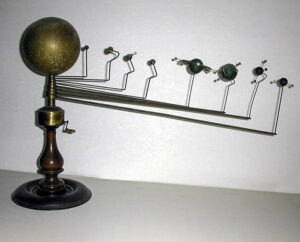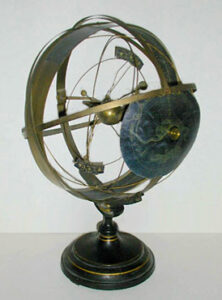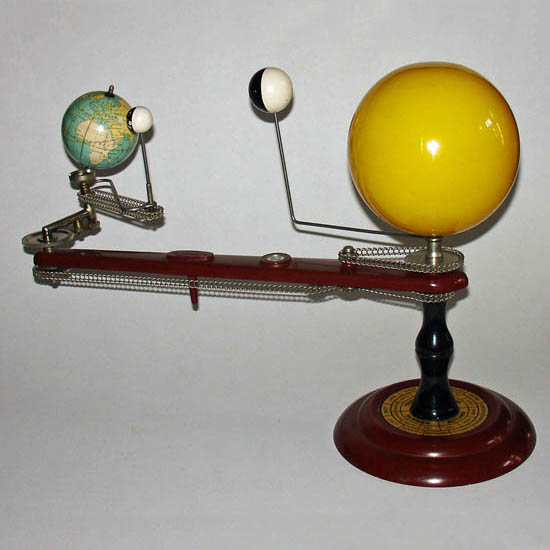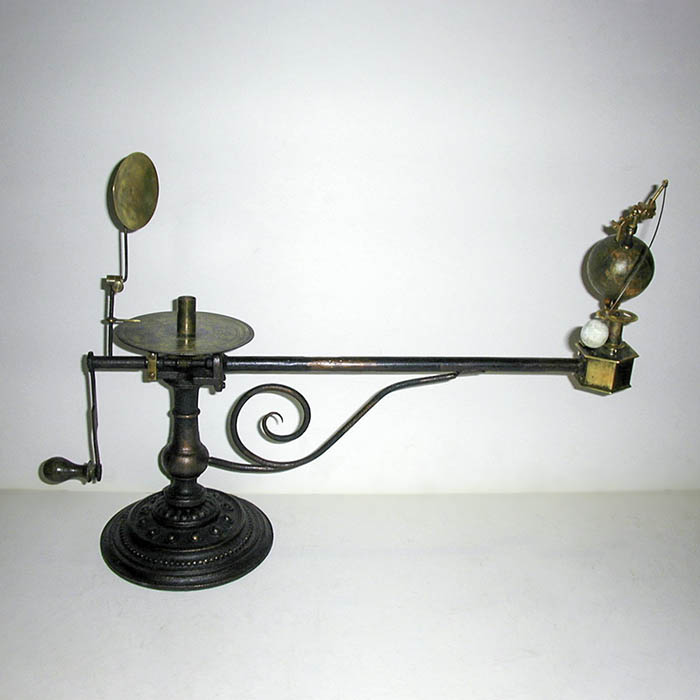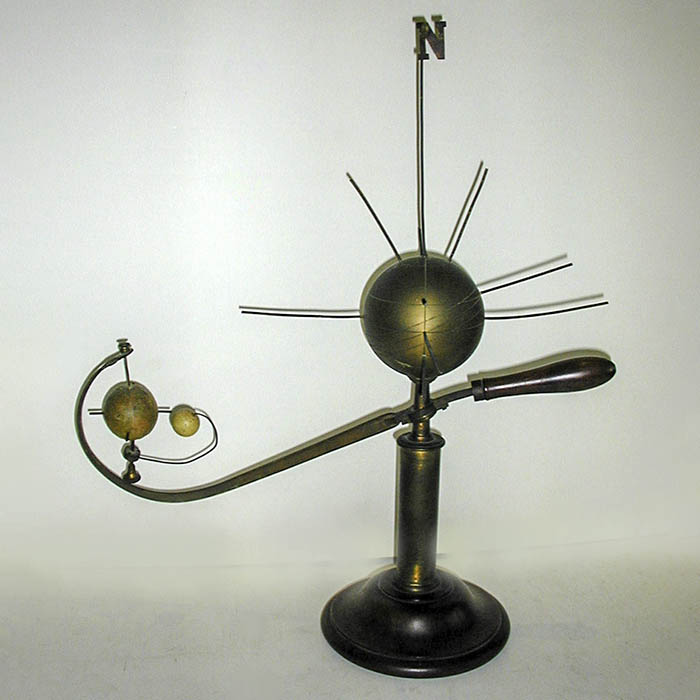
The George Glazer Gallery was featured on the July 25, 2002 episode of the television program Martha Stewart Living. In a segment titled "Collecting Tellurians and Orreries with George," Martha and George discussed the history and use of antique scientific models of the solar system used to study astronomy. They showed a selection of 19th and 20th-century examples. George also appeared on the show in 1999 and 2001.
Interview is transcribed below:
18th century men and children study astronomy with an orrery in an 18th-century print made after a painting by Joseph Wright of Derby. More about the print.
MS: George Glazer is a dealer in antique globes, and he's here with some of his favorite tellurians and orreries. Welcome back, George. Besides being useful scientific tools, people are using them decoratively in their homes. What got you interested in them?
GG: Like globes, planetaria are all encompassing -- they are at once scientific and historical instruments, and they are also great-looking quality decorative arts objects.
MS: Do scientists and astronomers still use them today, or is it more for schools?
GG: The antique ones, and the ones being made today, are demonstration devices primarily designed to teach students basic planetary motion and principals of astronomy. They're not to scale, and aren't flexible enough to explain more advanced concepts. Science teachers might use them today to teach basic concepts, though.
MS: When was the orrery invented?
GG: The orrery is named after an Englishman, Charles Boyle, the Earl of Orrery. In the 18th century, he commissioned a complex planetary device with the sun, the planets, and their moons. An orrery is used to study the relative sizes and motions of the planets in the solar system. Today, the original orrery is in the Science Museum in London.
MS: I became fascinated by orreries during a charity renovation project years ago-- the original owners left a 19th Century orrery in the house. I see you brought a similar one.
GG: Yes, yours was by Holbrook. In America, one of the first makers of such devices was the Holbrook family of globe makers. This one dates from about 1850. It's operated by clockwork gears, and is made up of spheres on wire armatures representing the planets (and their moons) that turn around the central brass or gilt wood sphere representing the sun.
MS: This interesting device seems to have an orrery inside, but looks a bit like a garden armillary sundial from the outside with all those concentric rings.
GG: It's a Bryant Celestial Indicator — a combination orrery and armillary sphere, made in Hartford, Connecticut, by Henry Bryant in the 1870s. The armillary sphere shows planetary orbits, the zodiac band of constellations, and terrestrial and celestial measurement circles such as the Tropics of Cancer and Capricorn and the Equator. If you look inside you can see the orrery — all the different planets, including the earth and moon, that revolve around the central brass sun. You turn the planets by hand — there is no gear work.
MS: I recently discovered a charming planetary device at an antique shop with a spinning earth and moon by a company named Trippensee. How does that compare to these orreries?
GG: Trippensee was the leading American manufacturer of tellurians from the early 20th Century, located in Detroit, Michigan. Tellurians don't include all the planets like an orrery does. They're used to demonstrate and teach the relative motion of earth, moon and sun, and help explain the phenomena of day and night, the four seasons, and solar and lunar eclipses.
This example is from the early 20th century with a maple arm. It has a brass sphere representing the sun, a 3-inch earth globe, and two wooden spheres -- one representing the moon and the other Venus.
It's driven by driven turning the wooden arm by hand, and has chains that mesh with gears so that the earth spins, and the earth, moon, and Venus revolve. Often a zodiac scale is affixed to the base.
MS: How are they used in study?
GG: Tellurians demonstrate several natural cycles: that the earth spins once a day and revolves around the sun once a year, the moon revolves around the earth once a month, and Venus revolves around the sun at a different rate than the earth.
MS: What are these other tellurians? This Art Deco style one looks more like the one I found for my daughter Alexis?
GG: This is a more recent tellurian, made by Trippensee probably in the 1960s. The company no longer used a wooden arm and brass sun, but a dense plastic instead. It's a more modern look, but functions in the same way as the older ones. The Trippensee company is still in business making tellurians and other astronomy devices, now owned by Science First in Buffalo, New York.
MS: What is this cast iron tellurian?
GG: This one was made in Prague in the late 19th Century by Jan Felkl & Sons — a prolific maker of globes and tellurians. It operates by a slightly more complex mechanism than the Trippensee. A series of gears are engaged by this crank handle.
MS: How would you suggest decorating with planetaria?
GG: There are no rules, of course. It's whatever appeals to you. They're best placed where there's enough room to turn them. They have a library look, but work in any room. They still serve an educational purpose, so they're great for children to study astronomy. This French tellurian was made in the 19th century and is very decorative with rods emanating from the sun and earth, marking celestial circles and rotational planes. It's a sort of abstract sculpture in its own way. It's possible that this is a handmade tellurian, rather than a manufactured object.
MS: Are planetary devices very expensive?
GG: The prices vary dramatically. Trippensee still produces a variety of inexpensive tellurians. Antique and vintage tellurians vary tremendously in price. As with other collectibles, factors include quality of manufacture, age, condition, rarity, etc.
MS: Where can you find planetaria?
GG: Since American devices were commonly used in schools, they often ended up in homes around the country when they were thought to be obsolete and were disposed of. So, little by little, they tend to come to the marketplace as the contents of old houses are reviewed and sold. On my web site, I feature a variety of globes and scientific instruments, including tellurians and orrerries.
MS: Thank you, George. Tellurians and orreries are not only good learning tools, but are also a beautiful way of bringing the sun, moon and planets indoors.
Note: If you are interested in learning more about tellurians and orreries, see About Planetary Models.
View our current inventory of planetary devices.
Copyright ©2002-2020 by George D. Glazer. All rights reserved. No part of this document may be reproduced in any form or by any means without written permission of the author.


